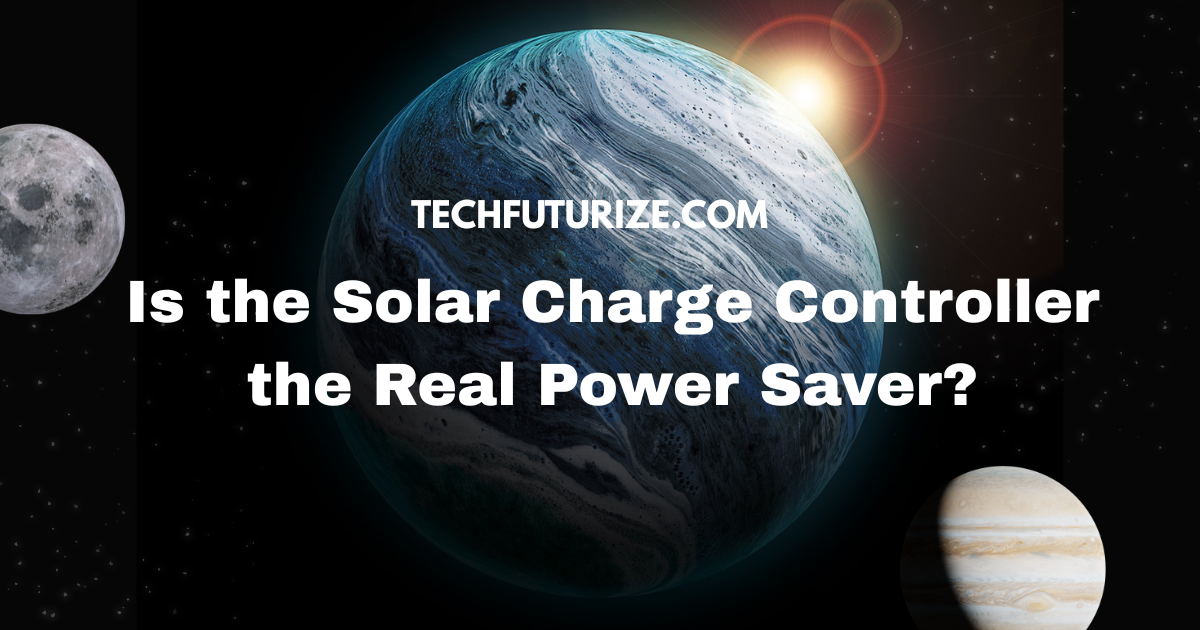Table of Contents
Beginning
Is a Solar Charge Controller a real power saver? This question makes suspense in tidal energy users who wish for more and more energy performance. A solar controller plays an important role in regulating the voltages and stopping the battery for more charging, ensuring the flow of electricity from panel to storage.
In today’s world of energy knowledge, this compromise that how solar controllers work helps in saving more money. From the type of PWM to MPPT, this smart device’s performance balances security, which makes it essential for a stable energy system. Let’s explore all the latest facts about Solar charge, all about its features, pros and cons and others.
What Is a Solar Charge Controller and How Does It Work?
Overview of Solar Controller Functionality
Solar controllers monitor the electricity built from solar panels and control energy in batteries. It automatically adjusts voltage and current to ensure the stable conditions of charging. This innovation stops more battery charging and deeply discharging.
Types of Charge Controllers (PWM and MPPT)
There are two types of solar charge PWM (pulse width modulation) and MPPT (maximum power point tracking). PYM are ideal for short systems and less costs, while MPPT increases the alteration of energy and works effectively in adjusting the direct light of the sun.
Role of Charge Controller in Energy Regulation
Solar charge controller controls the flow of energy between the balance of solar panels and the battery. It ensures that energy is divided effectively and stops the increase of electricity that avoids loss of system. By stable the current and voltages, it remains constant performance and increases in solar productivity.
Key Features of a Solar Charge Controller
Smart Charging and Automatic Voltage Control
Solar charge uses smart charging technology so adjust voltages themselves for the effective flow of energy. It protects your battery from more charging and deep discharging. It ensures the stable life of the battery and intelligent voltage regulation.
LCD Display, Monitoring, and Connectivity Options
Modern solar controllers come with an LCD data display for real time data tracking. Users can easily monitor the situation of battery and charging current. Some modern models offer the facility of wifi and bluetooth connectivity for system management.
Temperature Compensation and Safety Functions
The technology of compensation of temperature helps in maintaining the surface level of charging in different weather conditions. Built-in increase over load protection short cuts and reverse polarity. These features make solar charge more effective.
Why is a Charge Controller important in Solar Systems?
The Solar charge controller is essential in the solar system because it controls the flow of electricity from panel to battery. Without this , batteries charge more and exhibit deeply, which affects the performance and age of batteries. Controllers ensure stable voltages and present surface, and balancing energy in the system. It also prevents short-circuits and reverse currents that might harm the components. Collectively, it increases the performance and security of systems which make it an essential part of every solar system.
How to install and maintain a Solar Charge Controller?
Step-by-Step Installation Guidelines
To install the solar charge you must connect the battery, then connect the solar panel and then load. To avoid the loss that reaches the system always ensure current polarity. For better performance, you need to install the charge controller at dry and cold places.
Safety Tips and Connection Instructions
Before installation, again check the voltage velocity and use effective tools for your protection. Avoid joining the solar panel directly to the sun to stop the access during live setup. Ensuring that you bind all wires safely to avoid loose connections.
Which Solar Charge Is Best for Lithium Batteries?
When the topic is about which solar charge is best for Lithium batteries, MPPT (maximum power point tracking) controllers guide them. These solar charge controllers are very effective, adjusting voltages and currents for more and more energy changes from solar panels. Instead of competing with PWM controllers, the MPPT unit ensures stable charging that combines with the desires of Lithium batteries. A large brands like Victron, Renogy, and EPEVER choose solar controllers to control the energy from panels.
How to choose the best Solar Controller for your system?
Factors to Consider Before Buying a Controller
Before you purchase a solar charge controller, you must focus on the type of charge (MPPT or PWM), velocity of voltages and factors like present facility. Find out protective features like over charges and shortcuts protection. The accurate balance of performance ensures long-term trust.
Compatibility With Solar Panels and Batteries
Your solar charge must match with the ability of your solar panels and voltages of battery. If your configuration is mismatched, it badly affects the performance. For the protection of the system and ensuring the flow of electricity, always check the statements carefully.
How to fix or reset a faulty Solar Charge Controller?
To reset or repair faulty solar controllers looks easier. To ensure the protection, start by disconnecting batteries, solar panels and loads. For loss and loose connections, you should monitor all cables which cause hurdles in the flow of current. After complete checking, again combine the components – First battery, then solar panels and load at end. If your problem remains constant, press the reset button of the controller (if available), or activate factory settings to refresh the system.
Comparison between PWM and MPPT Solar Controllers
Efficiency Differences in Energy Conversion
The performance of MPPT controllers is more than 95%, while the PWM controllers show a maximum of about 75-80%. MPPT technology adjusts input voltages for more and more power output, especially in critical conditions of sunlight. This makes MPPT ideal for solar systems.
Cost, Durability, and System Compatibility
According to stability and costs, PWM is prominent for small set ups and budgeting plans while MPPT models are more expensive but it offers a long-term battery life. MPPT controllers also work better with modern solar panels and battery banks.
What are the Pros and Cons of using a Charge Controller?
Main Advantages of Installing a Solar Charge
The big advantage of the solar charge controller is that it has an ability to stop the battery for more charging and avoid electricity loss. It improves the flow of voltages from solar panels and ensures stable energy. Moreover, it increases the life of the battery and improves the performance of the system.
Common Drawbacks
Instead of its benefits, there are some limitations for the type and set up of solar charge. Lower-end models may reduce the performance in big systems. Besides, more expenses affects the collective performance of the system for high standards controllers, care and relevance issues.
Future Innovations in Solar Charge Controller Technology
The future of Solar controller technology looks bright with rapid progress of AI and IoT integration. Now smart controllers are designed now for adjusting charging patterns on the base of health of battery and strength of light of sun. In upcoming models, the care of better performance predictions and wireless monitoring also included. Manufacturers also focus on making compact designs and environment-friendly material to reduce waste.
Frequently Asked Questions (FAQs)
What Is the Ideal Capacity of a Solar Controller?
Ideal ability depends on your solar panel wattage and system voltage. Always select a solar charge controller that is almost 25-30% more controller than your total current panel.
Can It Work Without a Battery or Inverter?
Yes, solar charge works without a battery and inverter, but its performance might be reduced. It is basically designed to regulate charging and avoid batteries for more charging.
How Long Does a Solar Controller Last?
A high standard and quality solar charge usually works up to almost 10 to 15 years with suitable care. Avoiding over loading and regular checking or care also increases its life.
Conclusion
AT last, Solar Charge Controller is stand as a real power saver in any solar power system. It not only improves the alteration of energy but also ensures the protection and long-term use of your batteries. By maintaining the accurate surface of charge and stopping the waste of energy it increases the collective performance of the system. For each person who is in search of stable energy solutions and is cost effective, investing in standard solar charges is compulsory. Shorty, it is short but a powerful tool that creates a big difference in increasing solar energy.

